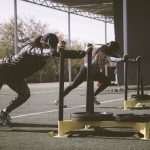The term “sport-specific strength and conditioning training” has taken on a completely different connotation, largely in part because of fitness and strength and conditioning industry being highjacked by marketers and globo gym. They have got us believing that you have to replicate or duplicate or imitate a specific skill that is done in the sporting field or an aspect of one’s sports in the weights room and strength and conditioning session.
Balancing a bosu ball or a swiss ball while doing a squat with a kettlebell in one hand and a ruby ball attached to a resistance band does not constitute sports specific. That simply translates to sheer stupidity.
Therefore the term “sport-specific” in our opinion means “specific to one’s sport or activity,” which means the individual should be engaging in perfect practice to improve their skill. That can only be done in ones given sports.
What we focus on is the ‘Seven S-factors’ of fitness, popularised by the late great Dr Mel Siff. The S-factors include:
1. strength
2. stamina (general cardiovascular endurance and local muscular endurance)
3. suppleness (flexibility)
4. speed
5. skill (kinaesthesis, motor coordination and control)
6. structure (size, shape), and
7. spirit (psychological fitness)
Dr Siff sure was ahead of his time and propogateed I tend to look at fitness like this:
1. soft tissue quality (foam rolling, TPT, SMR)
2. flexibility (soft tissue length, static, dynamic, ballistic, PNF)
3. mobility (dynamic warm-up)
4. stability (isometric strength, core stability (anterior, lateral, rotational))
5. movement efficiency (activation work, corrective exercise (prehab), motor control, balance (proprioception), posture, strength balances, skill, technique, form, minimization of energy leaks, clean movement, etc.)
6. hypertrophy (sarcomeric and sarcoplasmic, cross-sectional area (CSA))
7. strength (limit strength (absolute strength), strength-speed, speed strength, starting strength (impulse), relative strength, upper body, core, lower body)
8. power (explosive strength, a rate of force development (RFD), neural drive, HTMU stimulation, rate coding, synchronization, intermuscular coordination, intramuscular coordination)
9. agility (load vector specific training, eccentric strength)
10. reactive ability (elasticity, plyometrics, ballistics, reflex potentiation and inhibition)
11. linear speed (sprint training, sledge work, towing)
12. quickness (reaction time, hand-eye coordination, contraction/relaxation sequences)
13. conditioning (local muscular endurance, energy system development (aerobic, glycolytic, phosphagen), power endurance, work capacity, GPP, SPP)
14. regeneration (nutrition, sleep, stress (distress, eustress), visualization, thermal therapy, cryotherapy, massage, SMR, vibration, EMS, supplementation, nutrient timing)
15. mental toughness (pain tolerance, drive, determination, motivation, desire, adaptability (to chaos), discipline, coachability, instincts, sports knowledge, kinaesthetic intelligence)
16. genetic gifts (anthropometry (leverages), somatotype, height, weight, body composition, fibre type proportions, tendon insertion points, anabolic and catabolic hormone levels, resistance to illness and injury, damping efficiency, stiffness, viscosity)
I know it’s complex but once you understand how these various components interact, you can now build the optimal athlete!
MAKE AN ENQUIRY FOR MORE INFORMATION AND PACKAGES

 RAWFIT est. 1999
RAWFIT est. 1999 
